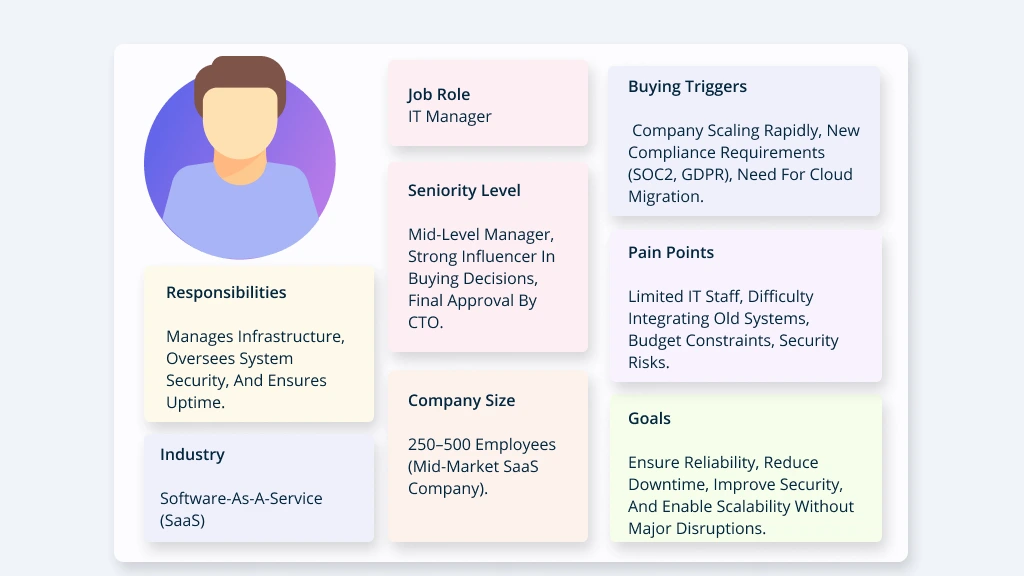What Is a B2B Buyer Persona?
A B2B Buyer Persona is a semi-fictional profile of a company’s ideal business customer, built using real data, research, and insights. It describes the type of person (or group of people) inside an organization who is involved in evaluating, influencing, and making purchase decisions for B2B products or services. Unlike simple demographics, a B2B persona goes beyond who the buyer is and explains why, how, and under what conditions they buy.
Importance of Making B2B Buyer Personas
Aligns Marketing and Sales
B2B buyer personas create a shared understanding of the customer across marketing and sales teams. Instead of working in silos, both teams can focus on the same target profiles, ensuring that campaigns, outreach, and conversations are consistent and aligned.
Improves Targeting & Segmentation
Personas help businesses prioritize the right prospects by identifying roles, industries, and company sizes that are most valuable. This sharper focus ensures that resources are spent on high-potential leads rather than spreading efforts too thin across broad audiences.
Shapes Better Messaging & Content
With clear personas, businesses can craft messaging that speaks directly to buyer needs and preferences. Content can be tailored to their pain points and interests, whether it’s ROI-driven reports for CFOs, technical guides for IT managers, or success stories for HR leaders.
Informs Product Development
Personas provide product teams with insights into customer challenges and desired outcomes. This ensures that features, improvements, and innovations address real-world problems, making the product more relevant and increasing adoption.
Shortens the Sales Cycle
By understanding common objections, goals, and decision-making criteria, sales teams can anticipate buyer questions and provide the right information sooner. This builds trust quickly and reduces the time it takes for prospects to move from interest to purchase.
Improves Customer Experience & Retention
Personas aren’t just useful for winning new customers; they guide support, onboarding, and retention strategies too. By tailoring engagement to customer needs and expectations, companies strengthen relationships and increase long-term loyalty.
Key Differences Between B2B and B2C Buyer Personas
B2B buyer personas are distinct because the decision-making process in business purchases is more complex than in consumer purchases.
Aspect | B2B Buyer Personas | B2C Buyer Personas |
Decision-Making | Involves a decision-making unit (DMU) with multiple stakeholders (managers, execs, users). | Typically one individual makes the purchase decision. |
Buying Cycle | Longer cycle with research, approvals, and budget justification. | Shorter cycle, often immediate or impulsive. |
Motivations | Driven by ROI, efficiency, compliance, and organizational impact. | Driven by personal needs, emotions, convenience, or lifestyle. |
Influence Factors | Based on data, measurable outcomes, case studies, and peer validation. | Based on price, brand affinity, social proof, and personal preferences. |
Impact of Purchase | Affects entire teams, departments, or company performance. | Primarily affects the individual buyer. |
Key Components of a B2B Buyer Persona
While a buyer persona is a semi-fictional profile, the components that make it up should be rooted in research, data, and real customer insights. Together, these elements explain not just who the buyer is, but how and why they make decisions.
- Demographic & Firmographic Details – Covers the basics such as industry, company size, job role, seniority, and location. These set the professional and organizational context.
- Psychographics – Captures goals, pain points, values, and challenges. This layer explains what motivates the buyer and what barriers stand in the way.
- Behavioral Traits – Looks at how the buyer researches, engages with vendors, and prefers to communicate. It includes channels they use, content they trust, and their decision-making style.
- Decision-Making Context – Defines the buyer’s influence or authority in the purchasing process, their key decision criteria, and the obstacles that might slow or block a deal.

How to Create B2B Buyer Personas in Creately
Step 1: Identify Your Best Customers
Start with your highest-value customers, the ones who buy premium plans, renew consistently, and have the highest lifetime value. These are your best examples of “ideal” buyers. Launch Creately and make a dedicated workspace to log these accounts and highlight what makes them valuable.
Step 2: Gather and Analyze Data
Use surveys, interviews, and direct feedback from customers, prospects, and your internal teams. Complement this with CRM data, website analytics, and social media insights. You can add sticky notes or tables for each source so you can cluster findings into patterns.
Step 3: Build the Persona Profile
Distil the research into core attributes such as job role, responsibilities, goals, pain points, and triggers. Creately’s B2B Buyer Persona templates lets you structure this information clearly in one place, making it easier to share across teams.
Step 4: Add a Narrative
Turn raw data into a short story about the persona, including who they are, what motivates them, and what obstacles they face. Use authentic quotes from interviews to humanize the persona. These can be added as a text box next to the persona card.
Step 5: Visual Representation
Make the persona easy to remember by adding a profile picture, illustration, or icon. Creately supports images, so you can upload visuals directly onto the persona card. This creates a character your team can connect with instead of just a data set.
Step 6: Map the Buying Process
Outline the decision-making journey: who gets involved, what level of influence they have, and what information they need at each stage. In Creately, you can draw this as a customer journey map diagram next to each persona, linking it to their role in the buying cycle.
Step 7: Refine and Share
Personas should not be static. Regularly update them with new feedback, CRM data, and market insights. Keep the buyer persona workspace accessible across your organization so sales, marketing, and product teams can stay aligned. Team members can comment directly on the persona, suggest edits, and make real-time updates, ensuring the profiles remain accurate and relevant as your market evolves.
Bonus Step: Use Creately’s AI to Generate B2B Buyer Personas
AI can help speed up buyer persona creation by transforming raw research into structured profiles. Instead of spending hours piecing together notes and spreadsheets, the AI organizes your research into a clear, structured profile. That way, you and your team can jump straight into refining and applying the persona, rather than wasting time building it from scratch. All you have to do is,
- Start by opening Creately’s AI B2B Buyer Persona Template.
- Tell the AI what kind of B2B Buyer Persona you need. You can add insights from interviews, surveys, CRM records, or analytics as inputs. This ensures the persona reflects real buyer behavior instead of being generic.
- Click ‘Generate’ to get a ready-made draft persona filled with the essential details.
Methods to Conduct B2B Buyer Persona Research
Stakeholder Interviews
Start by interviewing a mix of current customers, lost opportunities, and internal stakeholders like sales reps and customer success managers. Ask open-ended questions about what problems buyers were trying to solve, what influenced their decisions, and what nearly stopped them from buying. These conversations reveal motivations and objections you won’t see in raw data.
Customer Surveys
Distribute structured surveys through email, your product, or customer success outreach. Keep them short and focused on challenges, goals, and decision criteria. For example, ask what factors are most important when evaluating vendors (price, ROI, integrations, support). Incentivizing responses with small perks can increase completion rates.
CRM Data
Dig into your CRM to uncover patterns about who actually closes and who stalls in the pipeline. Look at job titles, deal size, sales cycle length, and common objections logged by sales teams. This provides a reality check, helping you base personas on proven buying behavior, not assumptions.
Web & Product Analytics
Analyze which content pages (case studies, pricing, webinars) drive the most engagement, and track which campaigns convert visitors into leads. For SaaS products, usage data (e.g., trail features or adoption rates) can indicate buyer priorities. Heatmaps, funnel analysis, and attribution reports add deeper insights into behavior.
Third-Party Data Sources
Enrich your personas with external insights such as firmographic and technographic data. Tools like LinkedIn Sales Navigator, ZoomInfo, or Demandbase can tell you the size, industry, tech stack, and growth stage of your target accounts. Industry reports and analyst research add broader market context, showing where your personas fit in the ecosystem.
How to Use Buyer Personas Across Marketing, Sales & Product Strategy
By applying personas across marketing, sales, and product, businesses ensure every team speaks the same language about the customer and works toward the same outcomes. This results in stronger engagement, faster conversions, and higher retention.
Marketing
Personas guide content creation, campaign targeting, and channel selection. By knowing a persona’s pain points and preferred content formats, marketing teams can design blogs, whitepapers, case studies, and ads that speak directly to their challenges and goals. Ad targeting also becomes more precise when personas define the industries, roles, and decision-makers to reach.
Sales
Personas help sales teams tailor their outreach and conversations. Instead of generic pitches, reps can address specific buyer objections, emphasize the value that matters most to their role, and align their messaging with the persona’s decision-making process. This shortens sales cycles and builds stronger trust.
Product Strategy
Personas influence product roadmaps by highlighting customer needs and usage patterns. Understanding their goals and frustrations helps prioritize features, integrations, and improvements that solve real-world problems. Personas also guide onboarding and customer success initiatives, ensuring the product delivers ongoing value aligned to expectations.
Free B2B Buyer Persona Examples
Helpful Resources for Making Buyer Personas
Discover our collection of buying persona examples you can customize for any industry.
Discover how to make a buyer persona using free editable templates.
Learn how to generate Buyer Personas with AI.
FAQs about B2B Buyer Personas
How many B2B personas should a company have?
Should negative buyer personas be created?
What’s the biggest mistake companies make with buyer personas?
How often should buyer personas be updated?
What questions should I answer when creating a B2B buyer persona?
To build a useful B2B buyer persona, you should answer key questions that capture both the professional context and the business needs of your ideal customer. These B2B buyer persona questions include,
- Job Role – What position or title best represents this persona?
- Responsibilities – What are the main duties and tasks they handle in their role?
- Seniority Level – Do they act as a decision-maker, an influencer, or an end-user in the buying process?
- Company Size – What scale of organization are they typically part of (startup, mid-market, enterprise)?
- Industry – Which sector do they belong to, and how does it shape their challenges?
- Buying Triggers – What events or changes usually prompt them to consider a purchase?
- Pain Points – What frustrations, risks, or inefficiencies are they looking to solve?
- Goals – What outcomes do they want to achieve, such as cost savings, growth, efficiency, or compliance?
Resources
Andersson, Svante, et al. “Challenges and Opportunities in the Digitalization of the B2B Customer Journey.” Journal of Business and Industrial Marketing, vol. 39, no. 13, 13 Aug. 2024, pp. 160–174, https://doi.org/10.1108/jbim-12-2023-0714.
Boyle, Rachael E., et al. “Iterative Mixed Method Approach to B2B SaaS User Personas.” Proceedings of the ACM on Human-Computer Interaction, vol. 6, no. EICS, 14 June 2022, pp. 1–44, https://doi.org/10.1145/3534523.






